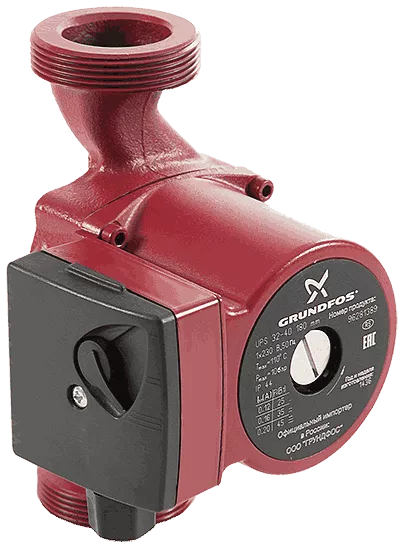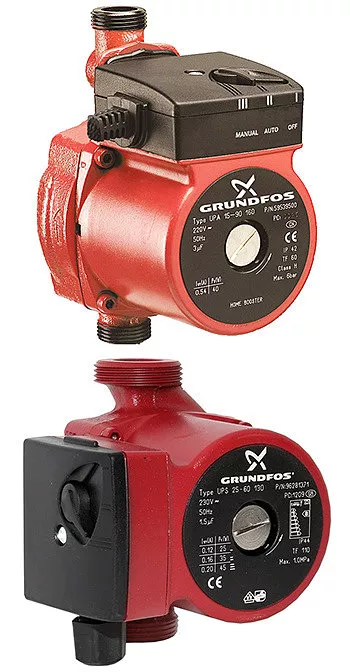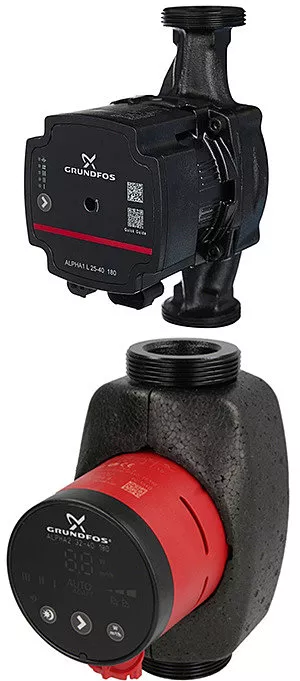Grundfos circulation pumps are designed for installation in independent heating networks. They are used to eliminate hydraulic resistance within the circuit. As the coolant moves through the pipeline, it slows down due to friction against the inner walls of the pipes. If the circuit is too long or extends across several floors, the pump inside the boiler may not be powerful enough. In this case, the fluid inside the pipes will quickly slow down or stop moving altogether. This will lead to uneven heating of the rooms.
A Grundfos pump is used to normalize the flow of the coolant within the closed circuit. It creates pressure that pushes the fluid through the pipes and circulates it at a uniform speed.
Advantages of Grundfos circulation pumps
This Danish manufacturer’s equipment has rightfully earned its popularity. It’s chosen for its many advantages.
Let’s look at the main ones:
- Reliability and high efficiency.
- Versatility. The units can be connected to systems of any configuration.
- Small size and light weight. Any device from the catalog can be installed even in a residential space.
- Virtually silent operation. The pump will not disturb you if you install it in a private house or apartment. Increased noise levels are observed only with very powerful models, but they are not suitable for domestic use.
- Easy installation. You can connect the equipment to the pipeline yourself (provided you have at least some knowledge of this type of work).
- High performance. The Grundfos pump is capable of moving any volume of coolant through a closed pipeline. It easily pumps liquid both horizontally and upstairs.
- Good efficiency. These units operate virtually lossless and consume little energy.
- Easy start-up. To start the equipment, simply connect it to the power supply.
- Convenient temperature controls. You can adjust the temperature during the initial connection. The device will then automatically maintain the selected temperature.
- Wide range of models. The manufacturer produces series of units designed for specific operating conditions. You can easily find the right model (or we’ll help you find one if you have any questions).

Types of Grundfos pumps

Circulation pumps of this brand vary in their characteristics and capabilities. Their classification is determined by several criteria. For example, the units can be single or dual. Most single units have only one rotor, with a maximum capacity of 4 atmospheres. These models are used in private homes. In contrast, dual units are more powerful and efficient. However, they are also significantly more expensive than single units.
Furthermore, the pumps differ in the rotor operation. It can be wet or dry. In wet rotor units, the motor is located directly in the coolant and does not have a protective capsule. These are typically simple motors that consume minimal energy and require no lubrication. Their capacity does not exceed 4 atmospheres. This rating provides approximately 3 m³ of coolant per hour, which is sufficient for a country house.
Grundfos circulation pumps with dry rotors have significantly higher power. Their motor is located in a sealed chamber and does not come into contact with the coolant. However, these units have their drawbacks: high power consumption and high noise levels. Therefore, they are not installed in country houses (they are also unnecessary in private homes, as such equipment is designed to pump large volumes of coolant).
These devices can also have different speeds. Single-speed units cannot have their speed adjusted. These are typically low-power models designed for private homes. Multi-speed units can be adjusted to the desired operating mode. They are more powerful and more expensive.
Model overview
Our catalog features various pump models. When choosing the right equipment, consider its specifications. You can also use a formula to calculate pump capacity. To do this, multiply the coolant volume by 3. The pump’s capacity should be higher than the calculated value.
Let’s look at the most popular models:
The Grundfos UPA 15-90 is a compact unit with a wet rotor. Its maximum head is 9 m, capable of pumping up to 1.6 m³ of coolant per hour. The unit can be configured in manual or automatic mode. It is corrosion-resistant and can be installed directly on the pipeline. This model operates silently and is suitable for installation in a country house.
The Grundfos UPS 25-60 is another example of equipment designed for domestic use. This unit delivers a maximum head of 6 m and can pump up to 3.4 m³ of coolant per hour. It features a wet rotor and three speeds. It is used not only in heating systems but also in air conditioning systems.
The Grundfos Alpha1 series of units is controlled by a PWM signal. Models in this line have a maximum pumping capacity of 3.8 m³ of coolant at a head of 6.5 m. All units in the series are highly energy efficient and feature automatic speed adjustment.
Grundfos Alpha2 is another line of pumps from this manufacturer. Models in this line can pump up to 3 m³ of coolant per hour at a head of up to 6 m. They feature night and summer modes, automatic speed adjustment, and other features. Current operating parameters can be viewed on the control panel.
Connection to the heating system
Connecting circulation pumps is done in the following order:
- Select a location on the return flow section of the pipeline. In this section, the coolant circulation rate is significantly reduced.
- Connection is made using a flange or coupling method. For home installations, threaded couplings are preferred.
- Seal the connection.
- Connect the unit to the power grid.

If you’ve connected your Grundfos heating circulation pump correctly, the unit will operate without any fluctuations or abnormal noise. If any problems occur, it’s best to reinstall the unit immediately, otherwise it will fail.


